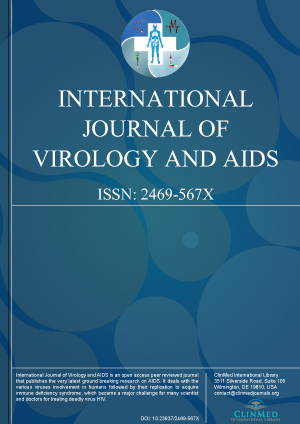Archive
Open Access DOI:10.23937/2469-567X/1510046
Chika Ejikeugwu, Peter Eze, Ifeanyichukwu Iroha, Charles Esimone, Michael Adikwu and Hirofumi AKARI
Article Type: Review Article | First Published: December 31, 2018
Article Formats
- Abstract
- Full Article
- XML
- EPub Reader
Open Access DOI:10.23937/2469-567X/1510045
Likawunt Samuel Asfaw and Fikre Enquselassie
Article Type: Original Research | First Published: December 08, 2018
Article Formats
- Abstract
- Full Article
- XML
- EPub Reader
Open Access DOI:10.23937/2469-567X/1510044
Infectious Characteristics of Ebola Virus
Manu Mitra
Article Type: Letter to Editor | First Published: November 07, 2018
Article Formats
- Full Article
- XML
- EPub Reader
Open Access DOI:10.23937/2469-567X/1510043
90-90-90, Epidemic Control and Ending AIDS: Global Situation and Recommendations
Reuben Granich, Somya Gupta and Brian Williams
Article Type: Review Article | First Published: September 17, 2018
Article Formats
- Full Article
- XML
- EPub Reader
Open Access DOI:10.23937/2469-567X/1510042
Microhomology of Viral/Host DNAs and Macrostructure of Herpesviral Genome
Felix Filatov and Alexandr Shargunov
Article Type: Research Article | First Published: September 01, 2018
Article Formats
- Abstract
- Full Article
- XML
- EPub Reader
Open Access DOI:10.23937/2469-567X/1510041
Modeling the HIV Epidemic: Why the 95-95-95 Target and ART Effectiveness Parameters Matter
Reuben Granich, Somya Gupta, Matt Wollmers, Mike Ruffner and Brian Williams
Article Type: Review Article | First Published: August 20, 2018
Article Formats
- Full Article
- XML
- EPub Reader
Open Access DOI:10.23937/2469-567X/1510040
Viral Infections after Kidney Transplantation: An Updated Review
Ethem Unal and Ahmet Topcu
Article Type: Review Article | First Published: July 01, 2018
Article Formats
- Full Article
- XML
- EPub Reader
Open Access DOI:10.23937/2469-567X/1510039
Samuel Kwadwo Afari and Emmanuel Awusah Blay
Article Type: Research Article | First Published: June 07, 2018
Article Formats
- Full Article
- XML
- EPub Reader
Open Access DOI:10.23937/2469-567X/1510038
Adherence to Antiretroviral Therapy among Adult Persons Living with HIV/AIDS in Southern Ethiopia
Hailu Chare Koyra
Article Type: Original Research | First Published: 10.23937/2469-567X/1510038
Article Formats
- Full Article
- XML
- EPub Reader

Volume 5
Issue 1
Issue 1
